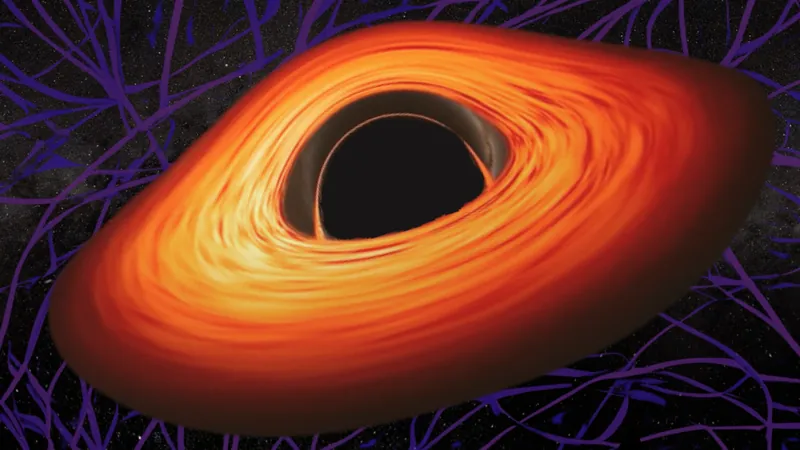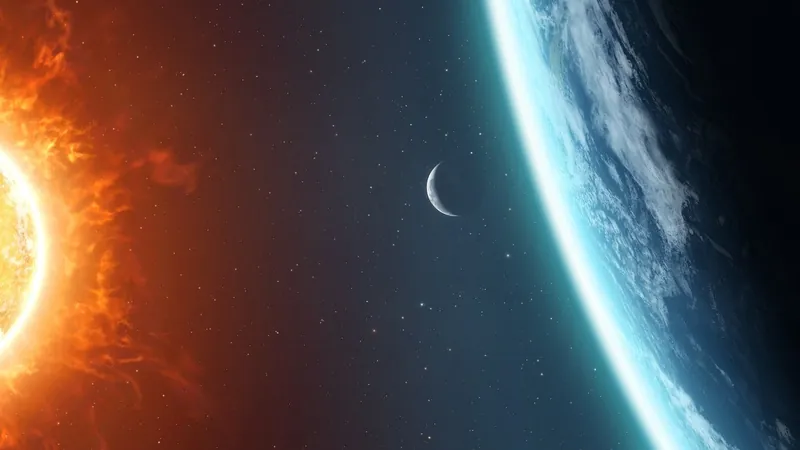
Did Dark Matter Unlock the Secret to Monster Black Holes in the Early Universe?
2024-09-28
Author: Mei
Introduction
Fascinating new research suggests that the elusive decay of dark matter could have played a vital role in the rapid growth of supermassive black holes during the universe's infancy. This groundbreaking theory could finally clarify some of the most puzzling observations captured by the James Webb Space Telescope (JWST).
Observations from JWST
Since its launch in 2021 and subsequent data transmission starting in mid-2022, JWST has detected supermassive black holes with masses in the millions, or even billions, of suns—existing as early as 500 million years after the Big Bang. This finding has left scientists scratching their heads, as current models predict that it would typically take over a billion years for black holes to accumulate enough mass to be deemed "supermassive."
Traditionally, one theory posited that these early black holes formed from massive gas and dust clouds collapsing directly. However, the new research proposes that dark matter could be a crucial ingredient in this process. According to Alexander Kusenko, an astrophysicist at UCLA and a member of the research team, “The formation of supermassive black holes is a mystery. Finding supermassive black holes when the universe was less than a billion years old feels like finding mammal bones among dinosaur bones in Jurassic rock.” This analogy underscores the need for a different explanation regarding their formation.
Role of Dark Matter Decay
The team asserts that dark matter decay may provide the necessary energy for large gas clouds to collapse into supermassive black holes, potentially resolving the longstanding mystery of their origin.
Exploring the Mystery of Dark Matter
Dark matter accounts for approximately 85% of the universe's mass, yet scientists remain largely in the dark about what it actually is. It doesn't interact with electromagnetic radiation—meaning it doesn't emit, absorb, or reflect light—rendering it invisible. Our knowledge of dark matter stems from observing its gravitational effects on visible matter and light.
Interestingly, some theories surrounding dark matter suggest the existence of unstable particles that might decay and release photons, the fundamental particles of light. The researchers believe that this emitted radiation could be a game-changer in the growth process of supermassive black holes.
The Black Hole Formation Process
Kusenko elaborated, “Gravity can squeeze a cloud of gas to produce a black hole, but normally, gravity acts on all scales, causing smaller parts of a larger cloud to collapse before the entire cloud can join together to form a mammoth black hole.” For direct collapse to occur, a counteracting influence must be present, and one feasible solution is gas pressure.
“If a gas cloud remains hot for an extended period, it won’t fragment into smaller parts. High pressure can counterbalance gravitational forces,” Kusenko explained. However, as gas cools, this pressure diminishes, allowing gravity to take over, leading to multiple smaller black holes instead of one massive entity.
In the early universe predominantly composed of hydrogen atoms, cooling was particularly significant. Heavy elements hadn’t yet formed due to the absence of stars, which typically create them through nuclear fusion. Hydrogen gas would interact without bonding, but when molecules formed, they could radiate energy and cool more efficiently. “The greater the number of hydrogen molecules, the more effective the cooling,” Kusenko continues.
Crucially, the decay of dark matter particles is thought to disrupt the formation of stable hydrogen molecules, allowing gas clouds much-needed time to collapse into supermassive black holes.
The Implications of Decaying Dark Matter
If this theory holds true, what does it reveal about dark matter? Kusenko outlines two possible scenarios: either dark matter particles decay slowly or there exists a subset that decays more rapidly while the bulk remains stable. “Understanding the types of radiation needed for black hole formation could inform us about the mass of these decaying particles,” he states, potentially leading to a breakthrough in identifying or ruling out this dark matter scenario.
In the cosmic race to uncover the fundamental nature of the universe, this research may shine a light on how some of the largest entities originated in the early cosmos, bringing us one step closer to solving the age-old mystery of dark matter. Could it be that this enigmatic substance not only shaped the universe’s composition but also guided the evolution of its grandest structures? Only time and further research will tell.




 Brasil (PT)
Brasil (PT)
 Canada (EN)
Canada (EN)
 Chile (ES)
Chile (ES)
 España (ES)
España (ES)
 France (FR)
France (FR)
 Hong Kong (EN)
Hong Kong (EN)
 Italia (IT)
Italia (IT)
 日本 (JA)
日本 (JA)
 Magyarország (HU)
Magyarország (HU)
 Norge (NO)
Norge (NO)
 Polska (PL)
Polska (PL)
 Schweiz (DE)
Schweiz (DE)
 Singapore (EN)
Singapore (EN)
 Sverige (SV)
Sverige (SV)
 Suomi (FI)
Suomi (FI)
 Türkiye (TR)
Türkiye (TR)